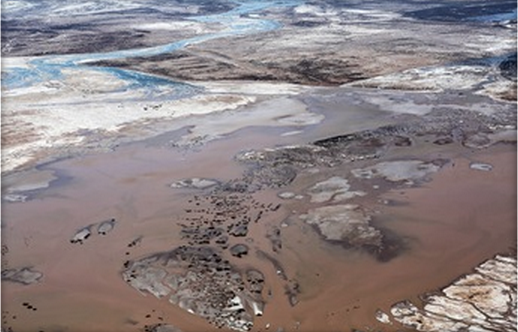Roundup of Global Volcanic Activity
Kilauea (Hawai'i): Some big changes in eruption activity here on Kilauea over the past few days. In the past 24 hours alone, 65 earthquakes were strong enough to be located beneath Kilauea Volcano! Gas emissions continued to be elevated at the summit over the past week as well.
Perhaps the biggest change in eruption activity was that the summit tiltmeters recorded almost 4 microradians of (possibly DI) deflationary tilt. The lava-lake level dropped slightly but is still at a measured 51m (167ft) below the floor of Halema'uma'u crater.
On the east rift zone at Pu'u 'O'o cinder cone, the USGS recorded about -2.3 microradians of deflationary tilt over the past 2 days. Via webcams glow is persistent from the north, south, and northeast spatter cones on the Pu'u 'O'o crater floor. From our observations, it looks as though the lava that spilled over the edge of the cinder cone last week to the south is forming a channel and, possibly a lava tube in turn, pointing towards the ocean. We are excited about this new activity on the east rift zone, which may allow us to safely and legally access surface flows once again here on Kilauea!
Currently erupting volcanos:
Ambrym (Vanuatu): active lava lakes in several craters
Bagana (Bougainville Island, Papua New Guinea): ash explosions
Barren Island (Indian Ocean): intermittent activity, likely strombolian-type and/or lava flows
Batu Tara (Sunda Islands, Indonesia): strombolian explosions, ash plumes up to 500 m, extrusion of a small lava dome with rockfalls
Colima (Western Mexico): extrusion of lava flow from summit, intermittent explosions
Dukono (Halmahera): thermal anomaly, probably small explosive activity in summit crater
Erebus (Antarctica): active lava lake in summit crater
Erta Ale (Ethiopia): active lava lake in northern pit crater, active hornito with intermittent flow in southern crater
Fuego (Guatemala): frequent moderate to large strombolian explosions
Gamalama (Halmahera): ash eruptions since 17 Sep
Grozny (Iturup Island): fumarolic activity
Heard (Australia, Southern Indian Ocean): likely lava lake in summit crater
Ibu (Halmahera, Indonesia): growing lava dome, occasional ash emissions
Karkar (Northeast of New Guinea): possible ash eruption on 1 February
Karymsky (Kamchatka): occasional small explosions, thermal anomaly
Kavachi (Solomon Islands): no eruption since 2007
Kilauea (Hawai'i): lava lakes in Halemau'uma'u and Pu'u 'O'o, lava flows on coastal flat and weakly active ocean entries
Kizimen (Kamchatka): degassing
Lokon-Empung (North Sulawesi, Indonesia): small explosions, lava flow?
Manam (Papua New Guinea): degassing, occasional ash venting
Marapi (Western Sumatra, Indonesia): sporadic explosions
Nishino-shima (Volcano Islands): lava effusion enlarging the new island
Nyiragongo (DRCongo): active lava lake in summit crater
Ol Doinyo Lengai (Tanzania): effusion of natrocarbonatite lava inside the crater
Reventador (Ecuador): intermittent explosions, lava fountaining and lava flow emission on 23-24 April
Sakurajima (Kyushu, Japan): ash venting, intermittent explosions
Santa María / Santiaguito (Guatemala): Santiaguito volcano (Guatemala): lava flow on south flank of dome becomes more active
Semeru (East Java, Indonesia): growing lava dome, ash venting and small to moderate explosions
Shiveluch (Kamchatka): growing lava dome, incandescent avalanches, occasional explosions
Sinabung (Sumatra, Indonesia): effusion of viscous lava, steaming, ash emissions
Slamet (Central Java): strombolian explosions from central crater
Stromboli (Eolian Islands, Italy): continuing lava overflows
Suwanose-jima (Ryukyu Islands): strombolian activity in summit crater
Tinakula (Santa Cruz Islands, Solomon Islands): increased activity at the volcano
Tungurahua (Ecuador): strombolian activity, effusion of lava flow on upper NW flank
Yasur (Tanna Island, Vanuatu): ash emissions, weak strombolian explosions




















